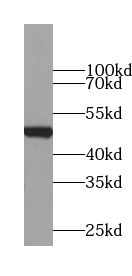GHRL antibody - 100 µg
Host : Rabbit
Clonality: Polyclonal
Clone:
Isotype: IgG
Immunogen: ghrelin
obestatin prepropeptide
Purity: ≥95% as determined by SDS-PAGE
Form: Liquid
Molecular weight: 15 kDa
Uniprot: Q9UBU3
Gene id: 51738
Background: This gene encodes the ghrelin-obestatin preproprotein that is cleaved to yield two peptides, ghrelin and obestatin. Ghrelin is a powerful appetite stimulant and plays an important role in energy homeostasis. Its secretion is initiated when the stomach is empty, whereupon it binds to the growth hormone secretagogue receptor in the hypothalamus which results in the secretion of growth hormone (somatotropin). Ghrelin is thought to regulate multiple activities, including hunger, reward perception via the mesolimbic pathway, gastric acid secretion, gastrointestinal motility, and pancreatic glucose-stimulated insulin secretion. It was initially proposed that obestatin plays an opposing role to ghrelin by promoting satiety and thus decreasing food intake, but this action is still debated. Recent reports suggest multiple metabolic roles for obestatin, including regulating adipocyte function and glucose metabolism. Alternative splicing results in multiple transcript variants. In addition, antisense transcripts for this gene have been identified and may potentially regulate ghrelin-obestatin preproprotein expression.
Field of research: Signal Transduction
Storage conditions: PBS with 0.02% sodium azide and 50% glycerol pH 7.3, -20°C for 12 months (Avoid repeated freeze
thaw cycles.)
Applications: ELISA, WB, IHC
Dilution: WB: 1:500 - 1:2000; IHC: 1:50 - 1:200
Target: GHRL
Purification: Immunogen affinity purified
Reactivity: Human, Rat

Clonality: Polyclonal
Clone:
Isotype: IgG
Immunogen: ghrelin
obestatin prepropeptide
Purity: ≥95% as determined by SDS-PAGE
Form: Liquid
Molecular weight: 15 kDa
Uniprot: Q9UBU3
Gene id: 51738
Background: This gene encodes the ghrelin-obestatin preproprotein that is cleaved to yield two peptides, ghrelin and obestatin. Ghrelin is a powerful appetite stimulant and plays an important role in energy homeostasis. Its secretion is initiated when the stomach is empty, whereupon it binds to the growth hormone secretagogue receptor in the hypothalamus which results in the secretion of growth hormone (somatotropin). Ghrelin is thought to regulate multiple activities, including hunger, reward perception via the mesolimbic pathway, gastric acid secretion, gastrointestinal motility, and pancreatic glucose-stimulated insulin secretion. It was initially proposed that obestatin plays an opposing role to ghrelin by promoting satiety and thus decreasing food intake, but this action is still debated. Recent reports suggest multiple metabolic roles for obestatin, including regulating adipocyte function and glucose metabolism. Alternative splicing results in multiple transcript variants. In addition, antisense transcripts for this gene have been identified and may potentially regulate ghrelin-obestatin preproprotein expression.
Field of research: Signal Transduction
Storage conditions: PBS with 0.02% sodium azide and 50% glycerol pH 7.3, -20°C for 12 months (Avoid repeated freeze
thaw cycles.)
Applications: ELISA, WB, IHC
Dilution: WB: 1:500 - 1:2000; IHC: 1:50 - 1:200
Target: GHRL
Purification: Immunogen affinity purified
Reactivity: Human, Rat

